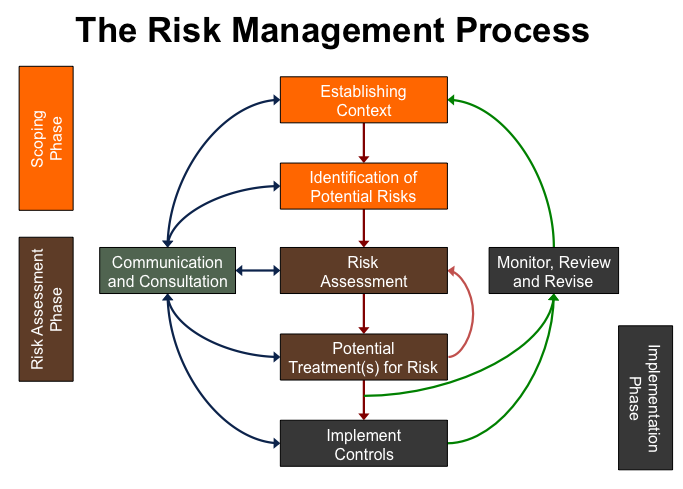Proactive risk management is an internationally applied method to reduce critical hazards associated with fatalities and improve operations to reduce injuries. It includes a framework of hazard scoping, risk assessment and control implementation phases (See Figure). Risk management legislation was implemented in the United Kingdom (U.K.) in the 1970s and the European Union and Australia in the 1990s and is codified in the ISO 31000 standard. In general, the U.S. continues to use a compliance rather than risk-based regulatory approach.

Risk Management in the Fire Service
In a prior FEMA-funded study (EMW-2008-FP-01536), we identified that the fire department with the most advanced risk management program (in the U.K.) had annual fireground lost-time injury rates four to 60 times lower than eight U.S., Australian and Canadian career fire departments, and these differences persisted when adjusted for the total number of firefighter responses. Similar patterns were found with training injuries, where the U.K. fire department also had the lowest lost-time injury rates.
We also collected information on the London Fire Brigade (LFB), who have used risk management-based interventions to reduce ESVCs, including a 40% reduction from 833 in 2008/09 to 496 in 2012/13, although the total number of responses decreased during the same period. Initial interventions introduced in the LFB included increased supervisor responsibility for ESVCs of their vehicle operators and station redesign to reduce the need for backing. Further interventions in the past eleven years have included: introduction of pumpers with improved braking performance and high level stop lights that helped prevent fire engines from running into the back of another engine; enhanced rear view mirrors; reversing cameras on single manned vehicles; high visibility diamond grade reflective striping to sides and rear of all blue light response vehicles; high visibility strobe effect blue lights as standard fitting; stowage in cabin area for all officially transported items of equipment; and noise reduction in the cabin area. In addition, LFB is planning a national project to provide telemetry including enhanced reversing/maneuvering visibility aides and vehicle operator behaviour heads-up information and data collection monitoring, all intended to improve safety and performance.
In 2009 we initiated a NIOSH R01 grant to assist the Tucson Fire Department (TFD) in the implementation of a risk management program. Based on TFD injury data, the three highest risk operations targeted included exercise, patient transport and fireground operations. Teams of TFD personnel ranging from front-line workers to administrators were formed, assisted by University of Arizona and Johns Hopkins research personnel. Examples of the selected interventions included: for exercise, revision of exercise SOPs, standardization of exercise equipment, and training in safe exercise techniques; for patient transport, implementation of a folding slide board for patient transfer on and off gurneys and purchase of power-lift gurneys; and for fireground operations, revisions of rehabilitation protocols and dehydration and three point vehicle exit training and notices.
Our initial results show a 34% decline in all injuries, and a 68% decline in fireground injuries. Workers’ compensation injury claims in 2012 totaled $211,139, reduced substantially from an annual average of $593,915 pre- intervention. Initial process evaluation data show that the risk management process was well received. In particular, obtaining input from all levels of the fire service was noted as one of the positive attributes of the risk management process. Engaging the firefighters upfront allowed them to be active participants in identifying risks and potential solutions, and bolstered buy-in when the interventions were implemented.
Risk Management in Other Industries
A few published studies on risk management are available for other industries. We demonstrated that risk management introduction from 1996-2003 was associated with a 52-78% reduction in lost-time injuries in the Australian coal industry, as compared to a 20% decline in the U.S. coal industry, which maintained a largely compliance-based regulatory approach. NIOSH studied the use of Major Hazard Risk Assessment (MHRA) to reduce injury from major hazards (e.g., fire, explosion, roof instability, etc.) in select U.S. mines and described how the risk management process was generally implemented successfully and that MHRA methodology helped companies go beyond measures required by regulation to implement potentially life-saving controls and recovery measures.
Risk Management in This Study
As part of Aim #1 of our study we worked with our partner fire departments and began risk assessment by creating risk registers to identify, describe and prioritize hazards as well as identify possible solutions for each hazard. Risk registers are specific to each department and the unique environmental and cultural challenges they face on a daily basis. Risk registers from the four participating departments can be found below.
Department D - Coming soon

